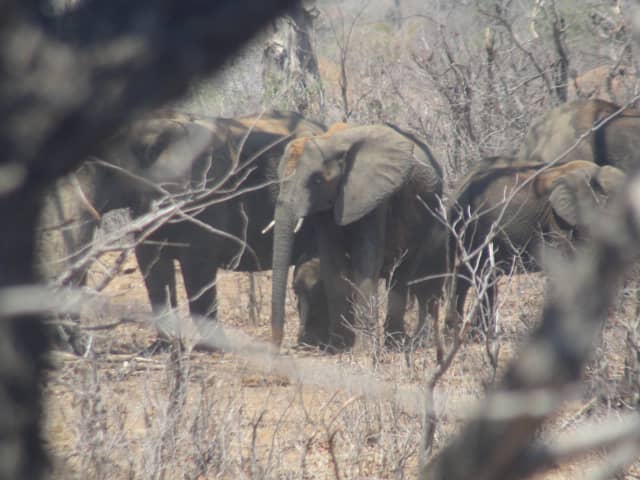By Africa Geographic Editorial
“Elephant damage!” is now a common phrase in reaction to the sight of fallen trees, and landscapes bereft of trees. The apparent loss of large savanna trees such as marula and knobthorn in Africa’s protected areas is often blamed on elephants, and this perceived direct link between elephants and treefall drives many conservation authorities and strategies to focus on managing elephant numbers in order to ‘save’ trees.
And yet, there is not necessarily a direct line between elephants and the ongoing loss of large trees, as there are many layers of complexity to the situation. A recent report ‘The management dilemma: Removing elephants to save large trees’ dives into this complex, important issue and comes up with some surprising and thought-provoking conclusions.
Here follows a brief summary of this report:
THE IMPACT OF HISTORICAL PREJUDICE
The report kicks off by explaining that management practise in the mostly fenced Kruger National Park has historically sided towards managing elephants in order to achieve an ‘ideal state’ with regard to trees, which is based on a colonial perspective, tourist expectations and the pursuit of an aesthetically pleasing (treed) landscape. And yet those historical records were based on a time when elephants had been largely exterminated from South Africa, from an earlier population of about 100,000 elephants – by poaching, recreational/trophy and subsistence hunting. And, the 19th century rinderpest outbreak resulted in the crash of herbivore populations. This absence of elephants and herbivores (which eat tree seedlings) resulted in trees dominating the landscape at the time that we now refer to as having the ‘ideal landscape’.
In the post-culling era, Kruger elephant numbers have again increased, but populations are restricted to smaller areas than historically. To add to the dynamic, the ‘ideal landscape’ is now largely determined by the needs of the photographic tourism industry.
ELEPHANTS AND TREES
Elephants utilise trees such as marula, knobthorn and red bushwillow for nutrition, and may strip bark, break branches or push trees over as they forage – with large bulls pushing over more trees than cows do. Trees that are trimmed down, rather than pushed over, become vulnerable to insects and fire.
By engaging in this ‘ecosystem engineering’ behaviour, elephants benefit ecosystems by improving plant diversity – opening up woody areas to grassland. Elephants are also important dispersers and germination agents of tree seeds, often depositing those seeds in a ball of organic fertiliser (dung) up to 65 km away from the mother tree, with the seed having a higher chance of germination after being exposed to acids in the elephant’s digestive system. Elephants produce up to 150 kg of wet dung per day, further enriching the ecosystem by promoting overall biological diversity and introducing micro-habitats for insects, frogs and reptiles.
On the other hand, the dominance of elephants above a certain threshold can, in conjunction with fire, result in the removal of large trees, and resultant reduction in diversity of birds, bats and small mammals.
CARRYING CAPACITY: A POPULAR MISCONCEPTION
The Kruger National Park culling program from 1967 to 1994 was based on maintaining a population of one elephant per square mile (0,4 per km²) – about 7,000 elephants in the 1.9-million-hectare national park. This figure, which was based on outdated agricultural parameters, became entrenched in the minds of former protected area managers and some sectors of the general public, and the current elephant population of over 20,000 causes much angst and discussion amongst those sectors of society. This application of a static carrying capacity figure to a dynamic ecosystem is no longer supported by current management thinking.
FENCED-OFF AREA SHOWS SAME LOSS OF LARGE MARULA TREES
A 300-ha area in northern Kruger was fenced off to breed roan antelope, during the time of the elephant culling program, and no elephants accessed the fenced-off area. Large marula trees within the fenced-off area disappeared from that landscape at the same rate as did trees outside of that area – indicating that other factors are also at play. Also, the lack of browsers in the 300-ha roan enclosure resulted in marula seedlings growing taller than they did outside of the fence, where impala and other small herbivores predate on significant volumes of tree seedlings and saplings. This lack of a clear direct relationship between dead marula trees and elephant numbers during the culling period suggests that elephants are not solely responsible for the loss of marula trees. There is a growing body of evidence that there is a complex relationship between elephants, fire and climate change when it comes to treefall rates and bush encroachment.
TSAVO AND CHOBE COMPARISONS
Both Tsavo (Kenya) and Chobe (Botswana) National Parks have seen elephant numbers fluctuate in the last two centuries under the pressure of poaching, with resultant impact on tree cover and populations of grassland grazers versus browsers. Both protected areas are currently seeing elephant populations recover to what they were before the 19th century ivory trade period, with resultant reinstatement of a landscape with fewer large trees. Also recovering in Chobe (from the rinderpest outbreak) are impala populations, resulting in increased predation on tree seedlings and saplings, further increasing the swing back to fewer trees and more grassland than existed historically.
MITIGATION METHODS
The primary determinants of tree extirpation have been found to be elephants, fire, soil and elevation – and therefore elephant density alone does not explain the survival and recruitment rate of large trees.
That said, the report does cover various lethal and non-lethal methods for elephant population reduction, and stresses that these points are made without reference to the obvious ethical considerations. The report also emphasises that each of these methods has advantages and disadvantages.
Lethal elephant population reduction
Culling was described in the report as not effective because it results in a spike in elephant birth rates, in response to more food per head, and the inter-regional movement of elephants into culling areas. Also, culling was found to have taken place in areas that did not match the natural spatial movements of elephants. Poaching reduced elephant populations by one third in seven years across Central and East Africa, but for obvious reasons this is not a supported elephant management tool. Trophy hunting was described as non-effective because the focus on male elephants carrying large ivory results in undesirable skewed sex ratios and age structures within populations.
Non-lethal elephant population reduction
The use of contraceptives has been shown to be successful in a number of smaller reserves in South Africa, including Greater Makalali Private Game Reserve and Tembe Elephant Park. The success of elephant translocations is dependent on additional land becoming available for elephants, and the impact of successful translocations is presumed to mirror that of culling.
Elephant movement and impact on trees is regulated by the spatial availability of water resources. For example, Kruger elephant bulls make use of artificial waterholes to range further away from natural rivers than do family groups, and the Kruger management strategy now includes the closure and spatial distribution of artificial waterholes to influence elephant movement. This strategy has already resulted in the annual elephant population growth rate reducing from 6,5% to 4,2% over a 12-year period. Importantly, the closure of artificial waterholes will also reduce the populations of tree seedling predators such as impala, further improving the survival rates of trees. To date Kruger has closed two-thirds of the 365 artificial waterholes and 50 earth dams.
By comparison, the privately-owned game reserves to the west of Kruger National Park that share an unfenced border with Kruger have not reduced the number of artificial waterholes, instead choosing to protect individual trees. They are experiencing a significantly higher elephant population than was the case before Kruger started closing their artificial waterholes.
Fences are also used to influence the spatial movement of elephants. Elephants also avoid fear zones – where threats to their safety are spatially predictable, but where the timing and type of threat are unpredictable.
Protecting individual trees
Protecting individual large trees is justified as a tool to maintain both the seed banks for future generations, and the aesthetic importance of trees as landscape features. In this regard, wire-netting prevents bark-stripping, and rock-packing and honey bees keep elephants away from the trees. Artificial propagation of tree seedlings increases the density of food plants, and has been successfully applied to diminish human-elephant conflict in Thailand.
Meta-population management
Reducing the poaching threat in neighbouring protected areas such as Mozambique’s Limpopo National Park could produce benefits for South Africa’s Kruger National Park, by reducing the ‘fear zone’ implications and increasing the movements of elephants out of Kruger and between these protected areas.
CONCLUSION
The authors of this report conclude that protected area managers face difficulties in protecting biodiversity where certain objectives may be in conflict. The question “Can large trees and elephants coexist and what strategies should managers implement to optimise biodiversity goals?” is a vital one facing protected area managers.
For more information about this topic, read ‘Decoding Kruger’s Elephant Management Plan’.







